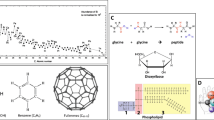Abstract
The spatial distribution of cations was assayed qualitatively and quantitatively in tentacular nematocytes of Hydra vulgaris in a scanning transmission electron microscope by means of x-ray microanalysis performed on 100 nm thick freeze-dried cryosections. The matrix of undischarged cysts (stenoteles, desmonemes and isorhizas) was found to contain mainly K+. In isolated nematocysts of Hydra the intracapsular potassium can be readily substituted by practically any other mono- and divalent cation (Na+, NH4 +, Mn2+, Co2+, Mg2+, Ca2+, Fe2+) all, except Fe2+, without impairing the ability of the cyst to respond to the chemical triggering with dithioerythritol or proteases. Monovalent cations increase the osmotically generated intracapsular pressure compared to divalent ions.
Similar content being viewed by others
References
Campbell, R. D. 1989. Taxonomy of the European Hydra (Cnidaria, Hydrozoa): a re-examination of its history with emphasis on the species H. vulgaris Pallas, H. attenuata Pallas and H. circumcincta Schulze. J. linn. Soc. Zool. 95: 219–244.
Gerke, L, 1989. Characteristics of the capsular wall of stenoteles in Hydra attenuata and H. vulgaris (Hydrozoa, Cnidaria) in context with the discharge mechanism. PhD thesis, Univ. of Zurich.
Gupta, B. L. & T. A. Hall, 1984. Role of high concentration of Ca, Cu and Zn in the maturation and discharge in situ of sea anemone nematocysts as shown by x-ray microanalysis of cryosections. In L. Bolis, L. J. Zadunaisky & R. Gilles (eds), Toxins, Drugs and Pollutants in Marine Animals. Springer Verlag, Heidelberg: 77–95.
Hall, T. A. & B. L. Gupta, 1982. Quantification for the x-ray microanalysis of cryosections. J. Microsc. 123: 333–345.
Holstein, T. & P. Tardent, 1984. An ultrahigh-speed analysis of exocytosis: nematocyst discharge. Science, N.Y. 223: 830–833.
Loomis, W. F. & H. M. Lenhoff, 1956. Growth and sexual differentiation of Hydra in mass culture. J. exp. Zool. 132: 555–574.
Lubbock, R. & W. B. Amos, 1981. Removal of bound calcium from nematocysts causes discharge. Nature, Lond. 290: 500–501.
Lubbock, R., B. L. Gupta & T. A. Hall, 1981. Novel role of calcium in exocytosis: Mechanism of nematocyst discharge as shown by x-ray microanalysis. Proc. natn. Acad. Sci. U.S.A. 78: 3624–3628.
Mariscal, R. N. 1974. Nematocysts. In L. Muscatine & H. M. Lenhoff (eds), Coelenterate Biology. Academic Press, N.Y.: 129–178.
Salleo, A., G. La Spada & M. G. Denaro, 1988. Release of free calcium from the nematocysts of Aiptasia mutabilis during discharge. Physiol. Zool. 61: 272–279.
Tardent, P. 1988. Hydra. NeujBl. naturf. Ges. Zürich 190: 1–100.
Tardent, P. & T. Holstein, 1982. Morphology and morphodynamics of the stenotele nematocyst of Hydra attenuata. Pall. (Hydrozoa, Cnidaria). Cell Tissue Res. 224: 269–290.
Tardent, P., T. Holstein, J. Weber & M. Klug, 1985. The morphodynamics and actions of stenotele nematocysts in Hydra. Archs Sci. Geneve 38: 401–418.
Tardent, P., K. Zierold, M. Klug & J. Weber, 1990. X-ray microanalysis of elements present in the matrix of cnidarian nematocysts. Tissue Cell 22: 629–643.
Weber, J. 1989. Nematocysts (stinging capsules of Cnidaria) as Dorman potential dominated osmotic systems. Eur. J. Biochem. 184: 465–476.
Weber, J. 1990. Poly (α-glutamic acid)s are the major constituents of nematocysts in Hydra (Hydrozoa, Cnidaria). J. biol. Chem. 265: 9664–9669.
Weber, J. 1991. A novel kind of polyanions as principal components of cnidarian nematocysts. Comp. Biochem. Physiol. 98A: 285–291.
Weber, J., M. Klug & P. Tardent, 1987a. Some physical and chemical properties of purified nematocysts of Hydra attenuata Pall. (Hydrozoa, Cnidaria). Comp. Biochem. Physiol. 88B: 855–862.
Weber, J., M. Klug & P. Tardent, 1987b. Detection of high concentrations of Mg and Ca in the nematocysts of various cnidarians. Experientia 43: 1022–1025.
Weber, J., M. Klug & P. Tardent, 1988. Chemistry of Hydra nematocysts. In D. A. Hessinger & H. M. Lenhoff (eds) The Biology of Nematocysts. Academic Press, San Diego: 427–444.
Zierold, K. 1986. Preparation of cryosections for biological microanalysis. In M. Müller, R. P. Becker, H. Boyde, J. J. Wolosewick (eds), The Science of Biological Specimen Preparation for Microscopy and Microanalysis. Scanning Electron Microscopy. Inc., Chicago: 119–127.
Zierold, K. 1988. X-ray microanalysis of freeze-dried and frozen-hydrated cryosections. J. Electron microsc. Techn. 9: 65–82.
Zierold, K., I. Gerke & M. Schmitz, 1989. X-ray microanalysis of fast exocytotic processes. In K. Zierold & H. K. Hagler (eds), Electron Probe Microanalysis. Applications in Biology and Medicine. Springer Verlag, Heidelberg: 281–292.
Author information
Authors and Affiliations
Rights and permissions
About this article
Cite this article
Gerke, I., Zierold, K., Weber, J. et al. The spatial distribution of cations in nematocytes of Hydra vulgaris . Hydrobiologia 216, 661–669 (1991). https://doi.org/10.1007/BF00026528
Issue Date:
DOI: https://doi.org/10.1007/BF00026528




